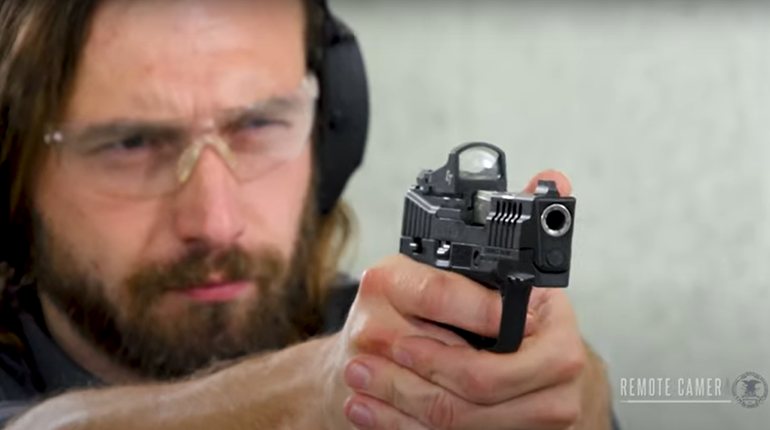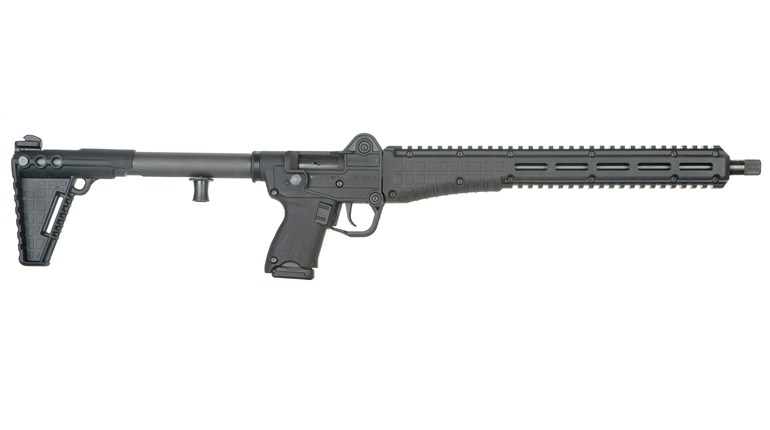
Canik pistols originated as budget clones of the Walther P99. Currently, Century Arms imports six variants of the TP9, from a basic, everyday-carry configuration to a high-speed, optic-equipped racegun. Its Elite Combat (EC) model is the most-recent offering, manufactured in Turkey, but designed in part by Salient Arms International. A striker-fired, tilt-barrel design, it is conventional on the surface, but features a substantial number of quite clever and technical tweaks.
The TP9 EC features a Cerakoted-polymer frame complete with steel rails and locking block. Its Salient-designed barrel measures 4.73 inches long, is fluted and has a nitride finish. The end of the muzzle has 13.5x1 mm left-hand threads and comes with a knurled thread protector with flats for the included wrench. To my surprise, the TP9 EC’s case contains a flush-fitting 15-round metal magazine along with a spare that boasts an extended plus-three floorplate. Also included are four micro-red-dot mounting plates compatible with just about every MRDS on the market, a magazine loader, an adjustable polymer holster with an unorthodox retention device, a large backstrap, a trigger lock, a cleaning jag, a bore brush and a disassembly instruction card. In short, Canik delivers most of the typical accessories straight out of the box.

First impressions are quite favorable. The pistol fits the hand well, with sufficient texture for retention without being abrasive, and the controls are all accessible while retaining a low profile. The Salient-designed, dovetailed fiber-optic front and non-glare, square-notch rear sights provide a good sight picture. The rear assembly is retained with two setscrews, but requires a pusher tool for adjustment. From the box, it appeared somewhat to the right of center. However, the rear sight would likely be removed and replaced with a red dot.
The real star of the TP9 EC is the trigger. Previous designs felt good, but could lock up if the finger was placed too high, or if side pressure was exerted, or if the crease (rather than the pad) of the finger contacted the safety tab. This trigger fixes these problems and provides one of the best experiences on a fighting pistol. Both the trigger face and the unusually wide safety tab are metal. The tab is hinged quite high, near the frame. Once take-up is met, the finger presses across the entire 11 mm width of the flat trigger face, making for an extremely controllable and comfortable experience. The pull weight is the same, around 4.5 pounds, but it feels crisper and repeatable, with around 1⁄16 inch reset conducive to controlled rapid fire. A red striker indicator protrudes from the back of the frame when cocked, permitting tactile verification in low light.

Another Salient part, the pistol’s magazine well, provides a wider funnel for quick reloads and a bit of a pommel to aid retention. The magazine-release button is located, textured and tensioned just right, and may be reversed for left-handed shooters. Magazines are of the standard 15-shot, metal, drop-free design. While a loader is included, they can be refilled simply by hand.
The ambidextrous slide-stop lever is easily reached with either thumb or forefinger, and features a nicely textured shelf. While it excels in its purpose, this lever almost always ends up held down by the thumb of the strong hand during firing, preventing slide lock on the last shot when the standard thumbs-forward hold is used.

Disassembly of the pistol is simple but unusual: verify clear, pull the trigger to decock, pull the slide forward 1 inch and lift it straight up. Reassembly is the same in reverse.
Shooting the Canik TP9 EC is quite pleasant: minimal recoil, moderate muzzle flip and a good trigger all add up to a feeling of confidence. The experience is further improved by 100-percent reliability with all kinds of ammunition, from 124-grain SIG Sauer JHP to 185-grain Seismic subsonic HP. The pistol feels equally good during single strong- or weak-hand shooting.
To test accuracy, I rested the gun in a two-handed hold over a sandbag. At 15 yards, groups centered between 2 and 7 inches above the point-of-aim, depending on the bullet weight. For control, I shot a target longslide pistol of known, solid accuracy, and it printed 3 inches above the point-of-aim with 115-grain ammunition. Groups were only about 40 percent larger than from the target pistol, which I find useful in determining the baseline competency of the shooter doing the testing.
The group shape, with minimal elongation but with one or two fliers out of every 10, suggests that the shooter’s skill was inadequate with the combination of sights and trigger. I also noticed that groups shot from a rest were considerably higher than those fired offhand, meaning that the motion of the pistol in recoil affected the point-of-impact. The pistol also twisted noticeably to the right when fired for accuracy, but that was not observed when firing it while in a defensive stance. At 25 yards, I had no trouble keeping all shots on a 6-inch plate, and at 50 yards on a half-size steel silhouette. My conclusion is that the accuracy is ample for the intended task, and would improve considerably once a red-dot sight is mounted on this pistol.




































